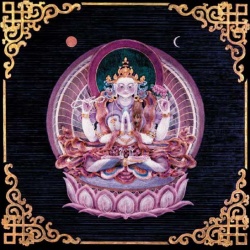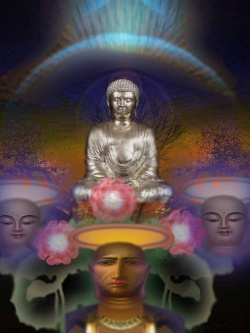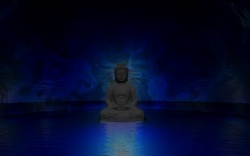An interesting question about meditation.
An interesting question about meditation.
I received the following question on the Go Deeper facebook page today:
I recently met a young high-functioning autistic person who is unable to visualize and feels that this hinders meditation. Do you have any suggestions?
Before I get into the nuts and bolts of the meditation question, I'd like to make one general comment about this.
As a former teacher, I've often noticed that when someone has been diagnosed (maybe quite correctly) as "autistic" or "dyslexic" or as having "ADD" they tend to think that every learning obstacle they encounter is a result of that difference.
Anyone with a learning difficulty should take heart that most of the things they find challenging are also challenging for many of the people who carry the label "normal". That is very much the case with visualisation! Many people find this tricky, and that's okay.
I wish that I could have talked to this person directly, because I can't be sure what kind of meditation they are struggling with, what they hope to get from meditating, and so on. However, that means I'll be a little more general, so maybe this will help more people.
Traditionally, most forms of meditation have not included visualisation.
There are exceptions, but most of the eastern forms focus on emptying one's mind, or focusing on one thing (a mantra, a candle flame, your breathing or your senses) to the exclusion of all else -- which ends up being pretty much the same thing. So the world of traditional eastern meditation is wide open to those who find visualisation difficult.
The meanings of the words meditation and visualisation have become somewhat muddled in recent times, and it's no wonder. One way to learn many of the traditional empty-mind styles of meditation is through the verbal guidance of a teacher, who takes you through the process step by step, leaving moments of silence for you to try to do what they have suggested.
This is "guided meditation" in its purest from. Usually, after a number of sessions the student is able to meditate without this guidance.
Then along came the hypnotherapy movement, the self-improvement movement and the new age movement, and suddenly there was an explosion of techniques and recordings and systems designed to help us relax, to realise our dreams, to meet our angel guides and everything else!
Many of these approaches combine elements of traditional meditation techniques such as relaxing the body and quieting the mind, with visualising something. This may be a scene or an object described by the person leading, or may be created from the imagination of the participant.
In some cases the "visualisation" is intended to be literally visual, but often ideas or feelings may work just as well. Let me see if I can explain that last part a bit better.
There are lots of reasons to do visualisations.
Relaxation (mentally putting yourself in relaxing environments), to create change (either in yourself or in the physical world, perhaps using what some people call the law of attraction) or perhaps to open yourself to some kind of deeper intuitive or spiritual experience.
Here the technique is often to create a space in which you are more open and able to listen to your intuition or a higher power - sort of like meeting it halfway.
For example, if you wanted to meet your power animal (supposing you believe in power animals -- it's just an example), you might be more open if you deeply imagine that you are in a forest, than you would be if you sit in your dorm room thinking "My power animal would never feel comfortable visiting me here."
We tend to use the word "visualise" in these contexts, when we could as easily use the word "imagine". Those of us who have a strong visual orientation often consider that a picture has more impact than words, or that a sensory experience does.
Okay, but I still don't see anything when I close my eyes!
How do you visualise? Can you picture your living room at home? Can you clearly see the various objects in their places? The color of the furniture? Can you picture how it would look if it was cleaner than usual, or perhaps more untidy than usual? Can you picture it with the walls painted yellow, or blue? (Stop reading and try this.)
If that's easy then your mind has a strong visual bent. If this is hard or feels impossible, don't worry. Maybe you are more of a word person, or a "feeling" person.
If you are a word person, you might be able to give quite a good verbal or written description of the room, even though the picture in your mind's eye is unclear, you know what is there.
If you are a feeling person, then you might find it easier to think about how you feel when you enter your living room, what you enjoy doing there, who you think of as being there with you and how you feel about that. This emotional stuff may be even more important than seeing pictures in your head.
Another thing to check is whether your other senses are also "blocked". Take note of your answers to the questions here. Try this: think back to your childhood. You are hungry and it is almost time for the evening meal. You are either in the kitchen or dining room anticipating the food. Can you remember what some of your favourite foods smelled like? How they tasted?
Were there certain sounds from the kitchen that told you dinner was about to be served -- like a pot being scraped, a microwave timer going off or someone calling? Can you hear familiar people saying familiar things? Can you see their faces? If you ate at a table, what did the surface of the table feel like? If you sat somewhere else, was it comfortable or awkward? What about your emotions? Was this one of the best times of the day for you, or was it a tense situation?
Was it boring? Were you in a hurry to get away? The answers to these questions will give you an idea of whether some of your senses are more vivid than others when it comes to remembering things or remembering things via your senses and emotions.
Now, just for fun, recreate another childhood evening meal. Only this time, make one up. Imagine a situation quite unlike the one you grew up in.
Maybe you are the child of parents who are gourmet chefs, or a Japanese child who hates the smell of fish, or a child growing up in an orphanage run by very strict nuns, or you are being raised by a doting grandma who stuffs you with treats.
Pick a scenario and see what it's like to try to answer the questions in the previous paragraph now.
Was it easier or harder for you to use your imagination, compared to using your memory? Did you find it fun to create this little story, or was it torture to try? Some people find visualising the past much easier than an imaginary situation. Other people don't have great memories, but may have vivid imaginations. Identify your strengths!
For those who have trouble visualising things which they haven't experienced, the problem is often detail. They are worried because they haven't visualised the leaves on the trees or the feathers on the birds. If you found recreating a memory easier than creating an imagined situation, it may be because you are confident about the detail.
But I'll bet you didn't really see everything when you remembered. Not the individual hairs on people's heads, nor the precise weather outside the window.
It's just too much work to put all the detail in -- so you trust that some of it is just there, quietly in the background. It's kind of like the perspective in a painting. The artist might paint the individual leaves on the tree in the foreground, but the ones on the far horizon might just be green blobs. We have to trust that those trees have leaves, too, just as we do when we look at real trees in the distance.
When I listen to a guided visualisation recording, or I create one in my own mind, details are among the "hooks" which keep me focused.
I have certainly experienced times when I couldn't see what someone was trying to show me, or what I was seeking, and it is frustrating. At these times, if I can't discipline my mind to cooperate, or perhaps the person guiding me isn't clear enough, I give myself permission to quit trying.
If I want to continue my meditation session, I just do some breathing or something. One thing about meditation is that it does take practice and discipline -- and if you use those things, it gets easier. Another thing is that you are not going to have a profound experience every time, whether you use visualisation or empty your mind. However, there are still many benefits!






